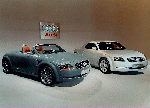
Audi TT
One of the biggest sensation was this little Audi coupé at the
1995 Frankfurt Show.
No previous details were known, no spy-photos. The secret mission of the
Californian Audi design-studio was accomplished.
Two years ago Freeman Thomas, the co-head of the design team who designed the
Volkswagen Concept I outlined the first drawings and with two other guys they
built it.
TT means "Tradition und Technik". It also refers to the NSU TT, a sporty
version of the '60s average family car, the NSU Prinz. Since then NSU has
been absorded into Audi.
The base of the car is next years' Audi A3. The engine was taken from the A4:
4-cylinder, 1.8 liter, with a max. power of 110 kW (150 hp) @ 5700 rpm.
The car has a kind of retro look with the front is reminiscent of the Audi
Avus racers of the '30s. From the side the shape reminds me to the Concept I.
The open, roadster of this 2+2 seater coupe will be revealed in Tokyo.
The DM50.000 coupe (and probably roadster)/ A3 pair will fight the Opel Corsa/
Tigra.
Images:
 Audi TT with a futuristic background
Audi TT with a futuristic background

 Audi TT - rear quarter
Audi TT - rear quarter
 Audi TT - rear
Audi TT - rear
TTS

The car was exhibited in Tokyo and then due to the overwhelming reaction
the Audi management decided to bring the pair to the market. Production
will start in 1998.
Technical differences will be displayed in the technical details table
found below.
| Type | TT | TTS | |||||||||||||||||||||||||||||||||||||||||||||
|---|---|---|---|---|---|---|---|---|---|---|---|---|---|---|---|---|---|---|---|---|---|---|---|---|---|---|---|---|---|---|---|---|---|---|---|---|---|---|---|---|---|---|---|---|---|---|---|
| Dimensions | |||||||||||||||||||||||||||||||||||||||||||||||
| Length | 4002 mm (157.6 in) | ||||||||||||||||||||||||||||||||||||||||||||||
| Width | 1751 mm (68.9 in) | ||||||||||||||||||||||||||||||||||||||||||||||
| Height | 1345 mm (53.0 in) | ||||||||||||||||||||||||||||||||||||||||||||||
| Wheel base | 2428 mm (95.6 in) | ||||||||||||||||||||||||||||||||||||||||||||||
| Front track | 1519 mm (59.8 in) | ||||||||||||||||||||||||||||||||||||||||||||||
| Rear track | 1499 mm (59.0 in) | ||||||||||||||||||||||||||||||||||||||||||||||
| Kerb weight | 1220 kg | 1240 kg | |||||||||||||||||||||||||||||||||||||||||||||
Engine
| Configuration
| Inlincd 4-cylinder, petrol engine, DOHC,
with turbocharger
| Displacement
| 1.8 l
| Bore
| 81 mm
| Stroke
| 86.4 mm
| Max. output
| 110 kW (110 bhp) @ 5700 rpm
| 154 kW (210 bhp)
| Maximum torque
| 210 Nm @ 1750-4600 rpm
| 210 Nm
| Mixture preparation/Ignition system
| Motronic, with sequential fuel injection and
adaptive oxygen-sensor control; cylinder-selective knock control, mapped
ignition characteristic; solid-state ignition distribution; 2 twin-spark
coils; self-diagnosis system and emergency-run program; fuel cut-off
when coasting.
| Driveline
| Layout
| Transverse engine, permanent four-wheel drive
| Clutch
| Hydraulically actuated single dry plate with ashbetos-free lining
| Transmission
| Five-speed manual-shift gearbox, full synchromesh
| Tyres
| 7.5 J x 18/ 225/40 ZR 18
| Performance/ fuel consumption
| Top speed (km/h; mile/h)
| 225 (139.8)
| 240 (149.1)
| Acceleration, 0-100 km/h (0-62 mile/h) (s)
| 8.0
| app. 6.0
| Average fuel consumption (three standard figures),
l/100 km/h (Imp./US mile/gal)
| 8.3 (34.0)
| 9 (31.4/26.1)
| Body
| Load-bearing, fully galvanized bodyshell; aluminium
lids and doors; impact-absorbing zones front and rear; additional side
intrusion protection.
| | ||||||||||